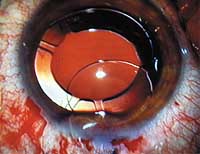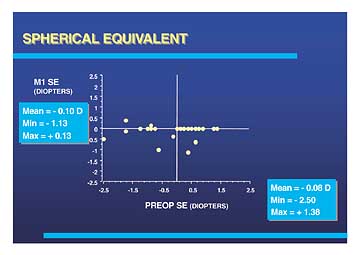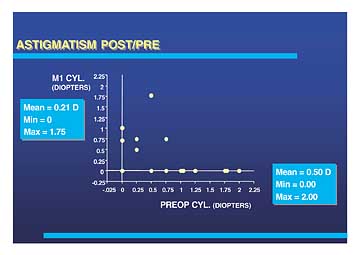Secondary piggyback multifocal implantation shows 90% success
This technique offers the possibility of explantation, with optical results that are predictable and functional results that improve with time.
 ---Multifocal
piggyback IOL.
---Multifocal
piggyback IOL.
Piggybacking is a safe technique if the two IOLs are independent. Placing one lens in the bag and the second in the sulcus can prevent cellular migration between the two piggybacked lenses, as reported by Gayton, who found no case of interlenticular opacification with bag/sulcus implantation. The use of two hydrophobic acrylic IOLs is inadvisable since acrylic has been shown to increase the risk of proliferative membrane.
Secondary piggyback implantation has primarily been advocated for the treatment of high hyperopia and for secondary correction of residual pseudophakic errors. Another indication is secondary multifocality.
Does emmetropia really ensure a 20/20 distance visual acuity after cataract surgery? Monofocality is a major refractive error and our purpose is to present the strategy and the first results of secondary piggyback multifocal bag/ sulcus implantation.
New plan to maximize multifocal success
 ---Secondary
sulcus implantation.
---Secondary
sulcus implantation.
At least three reasons can explain why over 60% of patients with primary multifocal IOLs need glasses: residual ametropia; existence of previous unrecognized eye disease; and the fact that some patients do not tolerate multifocality.
Secondary piggybacking with multifocal IOLs could be the solution.
First, secondary low-powered multifocal IOL insertion may correct both loss of accommodation and pseudophakic refractive error. The choice of incision location is important to reduce astigmatism.
Once the cataract has been removed, an easier diagnosis of eye diseases, amblyopia or age-related macular degeneration allows a better selection of patients.
A test of multifocal contact lenses can simulate the postoperative result and may exclude patients who could not stand multifocality.
IOLs
The multifocal lens is a PMMA IOL for sulcus implantation (Figure 1, 2), which is manufactured by IOLTech (La Rochelle, France), with a 5.75-mm optic diameter, a 13.5-mm overall diameter and a three-zone technology (distance near distance).
Power is available from –5 D to +5 D in 0.5 steps. The add for near vision is equal to 3.5 D.
Results
 ---Postoperative
vs. preoperative spherical equivalent.
---Postoperative
vs. preoperative spherical equivalent.
The first case was performed in August 1998. Results were very good, but I waited 6 months before operating on the second patient.
The primary patient inclusion criteria for multifocal piggybacking were: good motivation; good functional results after cataract operation; absence of other eye disease; and a positive response to multifocal contact lens test.
Today, 36 eyes of 20 patients have a follow-up of over 1 month.
Mean age was 61.9 years at the time of the second operation.
Most of the first implanted lenses were acrylic (20 cases, 56%) whereas 10 were PMMA (29%) and five were silicone (15%). YAG capsulotomy had been performed in nine cases (24%). Mean delay between the two operations was 18.2 months.
Before the second operation, the mean best corrected distance visual acuity was 0.96, and 97% of eyes were 20/25 or better.
One month after surgery, the mean uncorrected distance vision was 0.91, 85% of eyes were above 20/25 and 100% were better than 20/30. Mean best corrected distance visual acuity was 0.94, and 95% of eyes were 20/25 or better.
 ---Postoperative
vs. preoperative astigmatism.
---Postoperative
vs. preoperative astigmatism.
These functional results can be explained by the reduction of pseudophakic error, as demonstrated by spherical equivalent and astigmatism values.
Spherical equivalent ranged from –2.5 D to +1.38 D before secondary piggybacking and from –1.13 D to +0.13 D after 1 month. Thirty-one eyes (91%) were ±0.5 D (Figure 3).
The worse results are explained by residual astigmatism. Large incisions in cases of PMMA IOLs can induce astigmatism. However, at 1 month postoperatively, 27 eyes (79%) were ±0.5 D (Figure 4).
Near vision also is good. Prior to surgery, 100% of patients required glasses for near vision to read J2. After piggybacking, 83% of eyes read J2 without correction and 100% read J3.
In regard to the need for glasses, one patient needed glasses for distance and near vision, and one other patient needed glasses only for near vision. But 18 patients (90%) no longer require glasses.
Conclusion
Secondary piggyback multifocality works very well and patients are very satisfied. Optical results are predictable. Functional results are improving with time. All patients prefer their new multifocal vision.
Of course, this technique requires another operation with a second opening of the eye. But an important advantage is the possibility of explantation, for example, if macular disease occurs.
Although our results are very promising, more evaluation is necessary. A multicenter study with a longer follow-up is going to begin. Moreover, development of a new foldable IOL is in progress. I believe this technique is a new approach of multifocality, which is both promising and very exciting.
For Your Information:
- Jean-Michel Bosc, MD, can be reached at 5 bd Gabriel Guist’hau, 44000, Nantes, France; +(33) 2-40-20-21-46; fax: +(33) 2-40-12-15-14; e-mail: JMBOSC@aol.com. Dr. Bosc has a direct financial interest in the IOLTech multifocal PMMA IOL for implantation. He is not a paid consultant for any companies mentioned.
